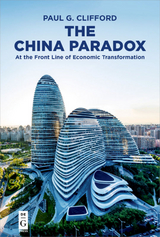The China Paradox
Paul G. Clifford, Non-resident Senior Fellow, Harvard Kennedy School, and President, Paul G. Clifford & Associates
Chapter 1: The Hybrid Model at the Heart of a Vibrant New China 1
Chapter 2: Early Attempts at Industrialization: The Empire and the
Republic 9
Chapter 3: The First Decades of the People’s Republic: The Soviet Model
… and Worse 17
The Fate of China’s Capitalists: From Ally to Enemy 18
The Dysfunctional Soviet Model Is Embraced 20
And Worse … Beyond the Soviet Model 26
The Brutal Assault on Intellectuals and Science 30
The Dead End of the Mao Years 35
Chapter 4: Wrongs Are Righted, the Reforms Take Shape 39
Setting the Boundaries of Change 46
The Initial Reforms—Limited and Tentative 47
The Reforms Go into a High Gear 51
The Reforms Lose Steam (2002 Onward) 52
China’s Economic Planning Today 53
Chapter 5: What to Do with the State-Owned Enterprises? 57
Weaning the SOEs Off the State (1978–93) 57
Central Planning Fades Away 60
Addressing Ownership and Governance (1993–2003) 62
Selling off the “Dogs” 62
Transforming the Large SOEs 64
Can SOE Culture Be Changed? 72
SOE Reform Falters (2003 Onward) 74
A New Type of SOE Shows the Way Forward 78
Chapter 6: The Private Economy Emerges Unannounced 83
TVEs—Engine for Growth as the Reforms Took Shape 84
POEs Flourish, Especially If Far from the Capital 87
Wanxiang—A Pioneering Private Company Forges Its Own
Path 88
Huawei—A Private Firm as “National Champion” 91
Private Firms Sustain the Economy 93
Chapter 7: Magnet for Foreign Investment 95
Why Did China Welcome FDI? 96
Why Has China Been so Attractive to Foreign Investors? 97
China Has Its Cake and Gets to Eat It, Too 99
Win-Win in the Auto Industry 100
Why Did China Neglect Logistics and Resist Its “Opening Up” to
FDI? 107
The Motorola Breakthrough 111
Why FDI Will Stick with China 115
Chapter 8: Business Models at the Heart of China’s Emergence 119
Model 1. Learn and Catch Up 119
Disappointment in Auto and Semiconductor 121
The Model Works Well—In Consumer Products, High-Speed Rail,
and Nuclear Power 124
Model 2. Picking off Underperforming Overseas Assets 129
Obstacles to China ODI 130
Model 3. “China, Inc.” in Emerging Markets 135
The Government/CCP 136
Financial Institutions 137
Chinese Firms 140
A Little-Known Firm from Anhui Grows in Africa 141
Transportation, Mines, and Downstream Industry 146
How to Assess the China, Inc. Business Model in Emerging
Markets 148
Model 4. Novel Product or Technology Breakthrough 149
Implications for the Emergence of Chinese Firms on the Global
Stage? 153
Chapter 9: What Could Disrupt or Sustain the China Paradox? 155
Peace, Stability and the CCP 155
The CCP Has Survived and Adapted 156
How Well Is the CCP Functioning Today? 157
The CCP Is Embedded in Businesses 159
China’s Fault Lines and Tensions 161
The CCP and China’s Future 161
The Rule of Law 166
Culture, Education, and Civil Society 168
A Cocktail of Confucianism and Leninism 169
Anything Goes, as the Market Latches onto Newfound
Freedoms 170
Corruption, Moral Turpitude, and Social Alienation 171
Education Falls Short 173
Business Education Flourishes 175
Economic and Financial Stability 175
Confronting the Environmental Crisis 179
The Mega Domestic Market 181
Gleaming New Ground Transportation Infrastructure 181
Government-Sponsored Research and Development 182
The Mobile Handset Example 186
China’s R&D Results Are Patchy 188
Connecting with the Consumer 190
Prospects of Deepening Economic Reform? 192
Chapter 10: Conclusion 197
Endnotes 207
Index 219
| Erscheinungsdatum | 10.05.2018 |
|---|---|
| Zusatzinfo | 10 Illustrations, black and white; 2 Tables, black and white |
| Verlagsort | Boston |
| Sprache | englisch |
| Maße | 155 x 230 mm |
| Gewicht | 439 g |
| Themenwelt | Sachbuch/Ratgeber ► Geschichte / Politik ► Politik / Gesellschaft |
| Geisteswissenschaften ► Geschichte ► Regional- / Ländergeschichte | |
| Sozialwissenschaften ► Politik / Verwaltung ► Staat / Verwaltung | |
| Wirtschaft ► Betriebswirtschaft / Management ► Finanzierung | |
| Wirtschaft ► Betriebswirtschaft / Management ► Rechnungswesen / Bilanzen | |
| Wirtschaft ► Betriebswirtschaft / Management ► Unternehmensführung / Management | |
| Wirtschaft ► Volkswirtschaftslehre ► Makroökonomie | |
| Schlagworte | China; Wirtschaft • Chinese Trade, CCP, Deng Xiaoping, Mao, Five Year Plan, Great Leap Forward, Cultural Revolution, Chinese Famine, Gang of Four |
| ISBN-10 | 1-5015-1574-8 / 1501515748 |
| ISBN-13 | 978-1-5015-1574-3 / 9781501515743 |
| Zustand | Neuware |
| Haben Sie eine Frage zum Produkt? |
aus dem Bereich




